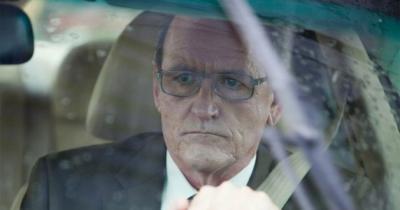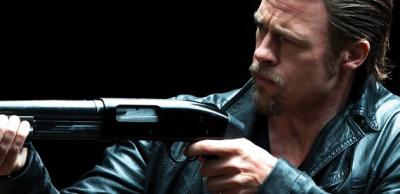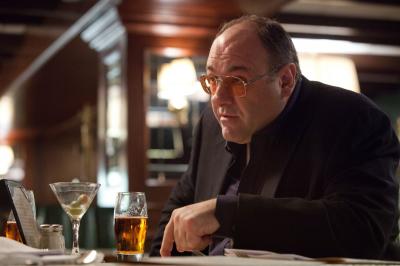By: debbie lynn elias
Adapted by writer/director Andrew Dominik from Charles V. Higgins’ 1984 crime novel Coganfs Trade, KILLING THEM SOFTLY moves from Higgins’ 1970’s mob-infested Boston to 2008 and the economic collapse in Anytown (or Everytown), U.S.A., where even the mob seems to be having some financial difficulties within its own governmental structure.
Leading the way is Jackie Cogan, mob enforcer brought in on contract to “take care” of a couple of nickel dime hoods who rolled a mob-protected poker game run by Markie Trattman. Sadly for Trattman, he’s not the brightest bulb in the box and got caught some years back with his own hand in the cookie jar thus now leading the mob higher-ups to want him eliminated as well. After all, Markie could have now committed a repeat of his prior indiscretions but, at the very least, hefs an incompetent who let the game be infiltrated and taken down by small time Johnny Amato and his leg men, Frankie and Russell. Either way is a win-win for the mob.
But, as he and Trattman are friends, Cogan has a problem with personally taking him down so he calls in Mickey, a washed up down on his luck hitman more interested in booze, broads and cocaine.
And while Cogan likes to call his own shots and stands on his mantra of taking out his assignments at a distance, i.e., “killing them softly”, the economic realities of being frugal with mob money in order to execute his orders may require him to get his hands a little dirtier this time. Seems that even the mob isn’t recession-proof as Cogan is continually reminded by his liaison, the messenger from the higher-ups, a man known only as Driver.
The cast reads like a who’s who of mob movies as writer/director Andrew Dominik not only reteams with Brad Pitt with whom he worked on The Assassination of Jesse James by the Coward Robert Ford, but brings in all the heavy-hitters, among them, – James Gandolfini, Ray Liotta, Max Casella and Sam Shepherd, and then ices the cake with Richard Jenkins, Scott McNairy and Ben Mendehlson.
An incredibly polished art house level film, KILLING THEM SOFTLY is riveting from start to finish thanks to an intelligently written script, compelling metaphor and analogy, rapier dialogue particularly between Pitt and Jenkinsf characters, flawless performances by Liotta, Pitt and Jenkins, and a visual texture that embodies the tonal essence of a 40’s or 50’s film noir film thanks to the new 500T 5230 film stock, used for the first time with this film.
I had a chance to speak with writer/director Andrew Dominick this week about KILLING THEM SOFTLY in this exclusive one-on-one interview:

I have to congratulate you on KILLING THEM SOFTLY. I am a huge fan of the 40’s and 50’s film noir gangster movies, crime novels and crime thrillers and what you have done here, metaphorically bringing this 1974 setting and concept into the 2008 geopolitical climate with a film noir spin is brilliantly done.
Well, thank you very much. I appreciate that.
One of the first things I have to ask you about is one scene that is an art house film unto itself – the shoot-out scene with Ray Liotta’s character, Markie Trattman. That one sequence is stunning. How did you go about designing and developing that scene with your Director of Photography, Greig Fraser?
We basically sat around and drew pictures and took photographs of the ideas, the sort of thing we wanted to see in the sequence. Then we pulled every toy out of the truck to make it work. It was kind of like everything but the kitchen sink in that sequence. We’ve got cameras running at a bunch of different speeds. We even got an old ballistics camera which shoots about 12,000 frames per second. You don’t even run film through it. It’s kind of like a spinning mirror effect that throws images onto the negative to be able to capture bullets coming of guns and stuff like that.
How many cameras were you using during this shoot?
I pretty much go for single camera coverage so you do one at a time, but that sequence has got a whole bunch of different types of cameras working.
One of the interesting things with this shoot is that you used one of Kodak’s new film stocks. You’re the first film to use it.
That stock came out just before we started. It was a beautiful stock, a high speed stock that really had just great range.
The result is absolutely beautiful. This is still the only thing I‘ve seen done on the 5230 and it fits the tonal bandwidth of the film so well.
Yea, I think Greig [Fraser] was pretty thrilled to find it.

How did this project come to you? While Higgins is well known, this particular book – Cogan‘s Trade – has been out of print for so long.
I went looking for it. I saw The Friends of Eddie Coyle on television and it was just so authentic and had a great mood and feeling to it that whoever had made it was somebody that obviously knew those people. So, I looked it up and found out it had been written by this guy, George Higgins, who had been a prosecutor in Boston for 20 years. Obviously he knew what he was talking about. [But] his books were out of print, so I just started ordering them from secondhand book sellers. Cogan‘s Trade was the third one that arrived in my mailbox.
What is it that jumped out at you in Cogan‘s Trade that made you want to turn it into a film?
Character, really. It was all about the characters initially. Then, the plot was very simple; sort of a Crime and Punishment type story. I quickly realized that it was the story of an economic crisis and it had some parallels with the current economic situation in the world in that it was a criminal economy, it was supported by gambling and collapsed because of a failure of regulations. And [then] when they had to clean it up, they had to deal with not only the problem but the perceptions of the problem so it was a political story, in its way. Although it was a very simplistic microcosm, it was a microcosm of what was going in the world at the time. And I’ve always felt that crime movies in some ways, the appeal of them, has got to be about that they describe the capitalist ideal because it’s the genre where its acceptable for all characters to just give a shit about money. Maybe that’s the real appeal of the crime film; that it’s about the American Dream, I guess.
I’ve always seen crime films as being that, especially the ones that are mob-centric as it simplifies the entire economic-political system.
Yes, it does. And I think that’s really what the mob are. They’re just a government for criminals. Obviously there’s parallels with the actual government which, certainly around the time of the economic crisis, did seem like it was a government for criminals.
How difficult was it for you to do the adaptation and how much of Higgins original dialogue did you retain, especially in those sequences with dialogue exchanges between Brad Pitt and Richard Jenkins?
Well, I think they might have been the ones that were the most mucked around with by me. For the most part, I retained all of Higgins dialogue where I could. I guess the things I added were the idea of murder being something that people were trying to avoid having to do, the idea of the higher-ups being absent and limp-wristed about dealing with problems, stuff like that. The rest of it was all Higgins. It was about the characters that he created that I was trying to preserve. But obviously, once it became more of a cartoonish film, and its set in Anytown, U.S.A. rather than Boston, the movie necessarily becomes a little more simplistic.
I know you shot in the New Orleans area post-Katrina. Although you can easily transplant the final look of this film and imagine it as being anywhere on the eastern seaboard, in the Great Lakes states, Detroit, etc., the “unidentifiable” New Orleans location works very well from the thematic visual standpoint. How beneficial was that to you in helping to propel the story and aid in the visual tone?
You know, it’s a story about economic collapse so I wanted to go shoot it in economically collapsed America. As luck would have it, those are the states that offer the best tax rebates for filmmakers. It was kind of a perfect situation. I had the choice basically between Detroit and New Orleans. New Orleans just seemed like a better idea because Detroit would have been too cold. And if you’ve got actors shivering in parked cars in minus 25 degrees, their faces are going to freeze and their performance is not going to be so good, so that’s how we ended up in New Orleans. The idea is that is that itfs not New Orleans, itfs just Anytown, U.S.A.
One of the great elements in the film is the music. Integrated with the film, the music buoys and compliments the action, the dialogue and the story elements. Did you write specific music into the script?
Yes, I did. A lot of it. The idea was that the whole world is talking to you. That the foreground story is commenting on the background story, the background story is commenting on the foreground story, that even the songs are sort of saying something to you. I like to use music to create distance rather than involve. A musical bit asks you to sit back and consider rather than telling you “this is sad, this is happy, this is scary” kind of thing. A lot of the stuff that I thought would be good was perhaps a little too on the nose and I ended up pulling back on that a little bit. It’s just sort of a trial and error thing. You try certain sounds, certain songs, certain pieces of music with certain images and some things feel right and some don’t.

Now, this is your second teaming with Brad Pitt. I thought what you delivered with The Assassination of Jesse James by the Coward Robert Ford was wonderful, but you’ve surpassed that with KILLING THEM SOFTLY. What is it that makes the two of you a good collaboration?
Well, we get along. We don’t see the world exactly the same way, me and Brad, but there’s enough of an overlap. I think the thing is primarily that we enjoy working with each other. We both understand each other’s working methods. Brad is a very very relaxed actor. He is one of the least worried guys that I’ve ever worked with. He really likes to play when you shoot. He’s a lot of fun to work with just in an actor-director relationship. I think Brad’s at a point in his career where he’s really wanting to use his powers to make movies that he wants to see that might not otherwise get made. His production company and him are working with really good directors, people like Terry Malick and Steve McQueen, and he’s really trying to make some great films. I feel very fortunate to be sort of included in that group.
You have a very strong point of view in your films. They are very character driven, you really get into the psychology of the characters that youfre delivering to us on screen. What is it about yourself that you think allows you to tap into that?
I guess I’m interested in people. People are fascinating to me. I find them to be mysterious and there’s always something more to the surface of anything. I find it very fun to sort of “go diving” inside a situation or inside people to find out why something is going on.
With the films that you’ve done thus far, you‘ve written and directed them. Would you want to step outside the box and direct other people‘s words?
You say that I’ve written and directed them, but I think it’s not really true because all three of the films have started with source material that’s been generated by somebody else. So while I may adapt that material, I guess I still regard to the author of Jesse James to be Ron Hanson and the author of this story to be Higgins. I guess I’ve added something to both things but it started with them. As far as straight screenplays, there’ve been a couple that I’ve been interested in doing but for whatever reason it hasnft panned out. It’s easier somehow to be involved. As a director, if you’re writing the material, you’re really inside everything. You know what to say to the actors.
When you‘re writing and knowing youfre going to direct, do you visualize your scenes or internally storyboard or do shot list as you‘re going?
Not really. You try to make it work before you start adding anything to it. Obviously, certain things suggest a visual treatment but other things are quite mysterious until you get there.

How did you go about casting KILLING THEM SOFTLY? From beginning to end, it is meticulously cast. And the pairing of Pitt and Jenkins is absolutely delicious.
My idea was to do it like an old studio picture and to cast “types,” instantly recognizable types. So youve got the fat guy, the goofy looking skinny dude, youfve got the sweaty Australian guy – almost like a cartoon. And then to typecast it with tough guys. So you’ve got “Tony Soprano” and “Henry Hill” in there, too. And the audience instantly understands who those people are. I guess in the case of Jim [Gandolfini] and Ray [Liotta] they kind of play against type a little bit but if they weren’t that type to being with they couldnft play against type.
That‘s one of the things that stands out for me about Liotta‘s performance. We‘re so used to seeing him as the tough guy and here hefs got that yellow streak in him.
I’m really impressed with Ray. A lot of male actors of a certain age are very much aren’t going to really get down and pussy-out like he did. But he was just fantastic and such a trooper. And so determined to make that [shoot-out] sequence absolutely skin-crawlingly repulsive.
Everything about his performance – that was one of the biggest surprises for me in the film, and it was a wonderful surprise to see for you to bring this out of Ray.
Thanks! That’s what we were going for. Most of the credit belongs to him. He’s a really good actor, Ray. I’ve been a fan of his since Something Wild.

And not only Ray Liotta, but all of your key performances, help make this film what it is.
Violence always depends on the performance of the victim, so you’ve got to get a good guy to be your victim.
When all is said and done, Andrew, what is the greatest gift that directing gives to you; and, especially directing a film like KILLING THEM SOFTLY?
Directing is the only thing I can. It’s the only job I’ve ever had. I kind of started at the top. [laughing] I went straight from film school to making commercials and music videos and stuff like that. At this stage I’m kind of screwed because I’ve got no other qualifications. I guess I “might” be able to work as a screenwriter, but I don’t know. I just love movies and I’ve wanted to make them. It always seemed like the director’s job was the job to do if you want to make films in the sense of actually physically putting them together. It’s a good job to have. You get everything. You get to use writing, there’s elements of theater, music, photography, you orchestrate everything to create some “thing” which is a work of art.
In this case, Andrew, it‘s a wonderful “thing” that you‘ve created with KILLING THEM SOFTLY.
#











